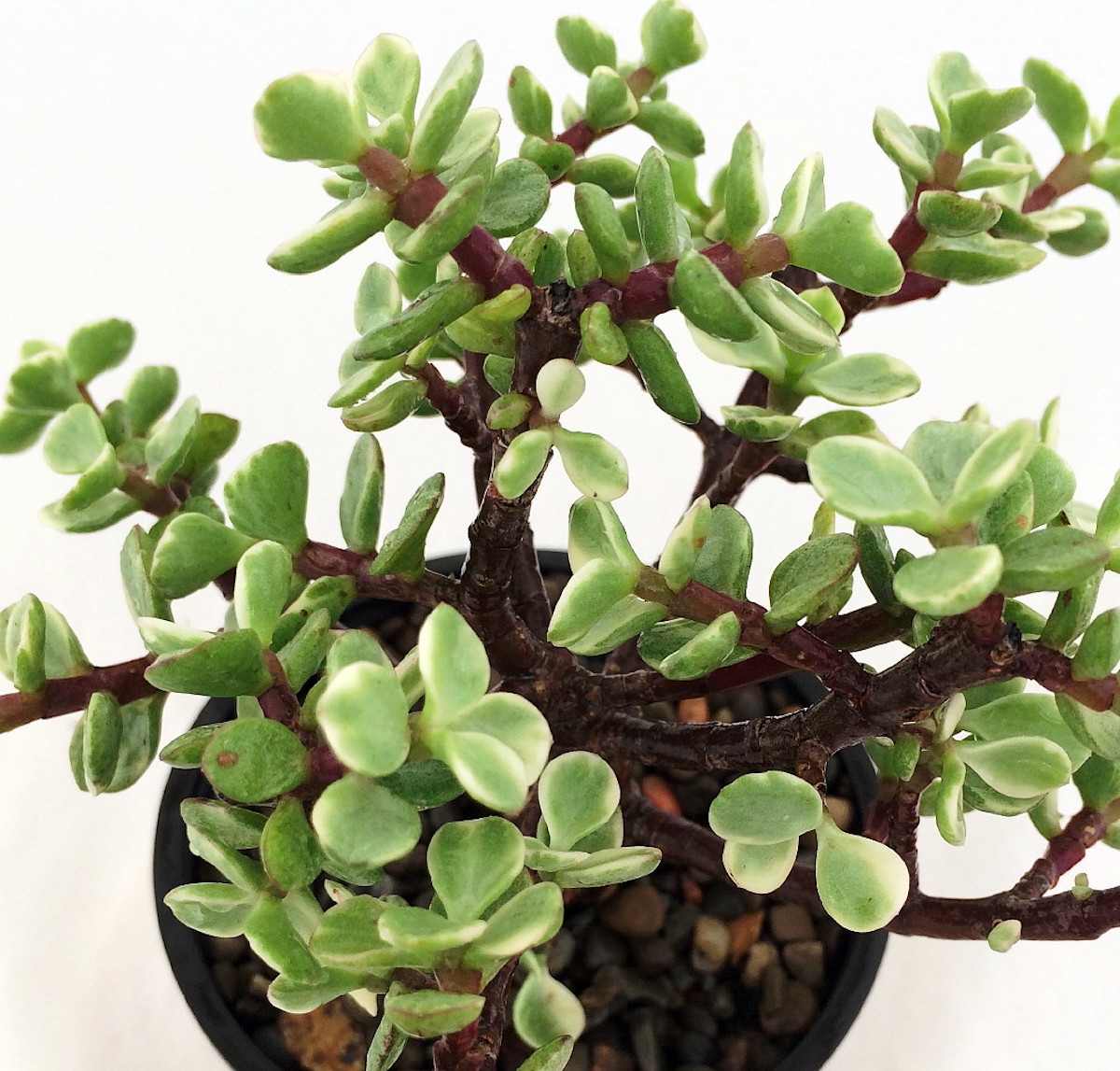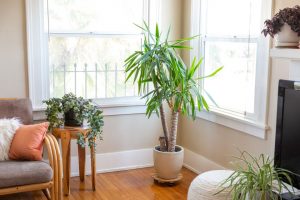We’ve all done it – bought an exotic houseplant with all the best intentions. And then, six months later, we discover it again on the window sill; a forgotten, yellow pile of brittle twigs and dead leaves.
Oh, the bad karma.
But, hey – it’s not always your fault. Plants are like us: they need the right conditions in which to thrive. And let’s face it: if we were stuck on a windowsill in the darkest, coldest corner of the home, we’d probably look a little miserable too.
Shame averted: check out our selection of ten hardy houseplants that would live through a nuclear detonation.
-
Pothos: The Devil’s Ivy

Image courtesy of Etsy
OK, so the nickname is a little on the demonic side, but don’t let that put you off. The pothos is a trailing vine with glossy love-heart-shaped leaves. It’s known as the “devil’s ivy” due to its ability to withstand shaded parts of the home and thrives even if you forget to water it for a while. And, unlike many houseplants, it won’t wilt if you overwater it.
If it’s super-happy in its given spot, your Pothos MIGHT flower, although it’s rare in the domestic environment. It produces little white flowers, but don’t expect them.
Grow in high-quality, well-drained potting soil.
Light requirements: bright, indirect light is perfect. However, Pothos is tolerant of low light and even fluorescent lighting. It hates direct sunlight.
2. Aglaonema

Image courtesy of Walmart
Aglaonema is a houseplant favourite – a water-tolerant Chinese evergreen. The leaves are long and almond-shaped, dappered between a deep green base and a patterned camouflage of light green – but some varieties come in pink, white, or red. That means that it will withstand too much water if you get a little over-zealous with the H2O.
The Aglaonema makes a great choice for an office plant because it’s so easy to look after and does well in fluorescent light conditions. Keep it away from hot or cold drafts – these plants won’t thrive on windowsills, near heaters, or air-con units.
Light requirements: These plants are happiest in partial or full shade.
3. Jade

Image courtesy of Walmart
The Jade plant is a beautiful bush-type houseplant with succulent leaves that retain water, so it can survive for long periods without any attention (other than to gaze at its beauty, of course). If the leaves begin to shrivel, it’s telling you that it needs water. As long as you don’t leave it too long, it will rehydrate and grow after watering.
Jades need plenty of sunlight, so a south/west-facing windowsill is perfect. Only water when the top one or two inches of soil are dry.
You can take cuttings from your jade – break off branches and plant them in soil – they’ll form new roots. Win-win.
Light requirements: Regular, bright light needed.
4. Asparagus Fern

Image courtesy of Amazon
Don’t try eating an asparagus fern – it’s asparagus in name only! Also, keep this plant away from your cats and dogs as it’s toxic for our furry friends. Warnings aside, this beautiful fern-like houseplant is super-easy to care for – it’s happy in bright spots or dark corners.
The abundant soft, feathery leaves make the asparagus fern a must-have for lovers of foliage. And every now and then, you’ll enjoy tiny white flowers towards the end of the summer.
Water only when the topsoil has dried out – give it a good watering in the sink, and let the residual watering drain out of the pot before returning it to its decorative pot.
Asparagus ferns love steamy environments, so the kitchen or bathroom would make it very happy.
Light requirements: dappled sunlight is best. It hates direct sunlight – it dries out its delicate foliage.
5. Chinese Money Plant

Image courtesy of Amazon
If you’re looking for a houseplant for your darker rooms, the Chinese Money Plant is your ideal choice. However, this lovely plant is happy soaking up the sunshine – just avoid direct sunlight. Indirect light is best.
Water it once a week, and it will brighten up dull rooms (and maybe bring you good fortune). Again, only water when the topsoil is dry; they hate soggy soil. If the leaves turn yellow and drop off, it’s usually a sign that you’re overwatering it, so hold back for a little while and make sure the pot is well-drained.
The striking circular leaves are flat and smooth, shaped a little like a penny (possibly hence the name).
Light requirements: Indirect light is best, although it’s equally happy in bright sun or shade.
6. Yucca

Image courtesy of The Spruce
Yuccas are the ultimate sun worshippers, so these need to be in bright, light rooms. Water your yucca sparingly, and it will thrive.
You can even let your yucca enjoy the outdoors during the summer if the weather is good – but ensure that it’s never exposed to frost. If you’re extra-lucky, it may develop creamy white/pink flowers, but it’s rare for a domestic plant to burst into flower, unfortunately.
Yuccas can grow into monsters, so give it plenty of space. This plant is toxic to dogs and cats if they eat the leaves, so keep them away.
Light requirements: Full sun.
7. Air Plant

Image courtesy of Air-Plants.com
You don’t get much easier than an air plant, which – literally – drinks nutrients and moisture from the air. Air plants grow without soil, making them perfect for steamy bathrooms and kitchens.
However, don’t get too excited because air plants do need SOME attention. When they’re happy, they produce little “pups” (or babies). And, if the air is dry, dunk them in water for a couple of hours every ten days. Mist them once a week to ensure they get enough moisture.
Position them around 3-5 feet from a window to ensure they get enough sunlight, although an artificial light source will also work. Most varieties can’t tolerate direct sunlight.
Light requirements: bright rooms are best or plenty of artificial light.
8. Spider Plant
Image courtesy of GardeningKnowHow.com
Yay, it’s the 1970s all over again! The Spider Plant is perhaps one of the most iconic of the houseplants, famed for its long, thin leaf stems and the little “babies” that sprout from the mother plant.
Given the right conditions, the spider plant is super easy to care for and can grow MASSIVE if given a large enough pot to enjoy. Nonetheless, spider plants are amazingly tolerant and will put up with a fair amount of neglect, so these are the perfect houseplant for busy moms! They just need well-drained soil, and they actually like to dry out now and then.
You know when a spider plant needs watering because the leaf stems become limp, and they become pale, rather than their customary deep, lush olive green.
And you can remove the babies from the mother plant for repotting!
Light requirements: Bright, indirect sunlight. They do OK in darker rooms.
9. Peace Lily
Peace lilies are as beautiful as their name and are amazingly tolerant of overwatering – so if you never know when to stop, this could be the plant for you. In fact, some experts say that peace lilies are so keen on the H2O, they’ll literally survive in a fish tank. Maybe don’t try that at home!
If these glorious plants receive enough sunlight, they burst into exotic, spade-like flowers with the most delicate, spiky stamens.
Low maintenance, with lovely glossy leaves and lovely flowers, peace lilies help to purify the air in your room.
Light requirements: They don’t need much light but will flower at their best with good, indirect sunlight.
10. Aloe Vera

Image courtesy of Amazon
Aloe thrives in indirect light, so it is a good choice for an office or bedside table. These beautiful succulents have long, spine-like leaves that store tons of water, so you don’t have to water them often – once every couple of weeks should be fine.
If you get sunburn, pick a leaf, squeeze out the gel and apply it directly to your skin. Aloe vera has many health benefits, but it’s particularly good for your skin and hair.
Like many of these easy-care plants, press your finger or thumb into the soil to test if it needs water. Press your thumb a couple of inches down – if you feel moisture, it doesn’t need watering. If it’s dry, then give it a good soak.
Light requirements: Prefers indirect sunlight.



Leave a Comment